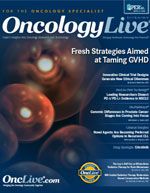Publication
Article
Oncology Live®
Leading Researchers Dissect PD-1/PD-L1 Evidence in NSCLC
Author(s):
Although lung cancer remains the leading cause of cancer-related mortality in the United States and 5-year survival rates are low at 17.8%, the grim picture for this tumor type is starting to shift to a more hopeful one as its biology is becoming better understood, facilitating treatment selection and providing researchers with new therapeutic targets.
Benjamin Levy, MD

Benjamin Levy, MD
Although lung cancer remains the leading cause of cancer-related mortality in the United States and 5-year survival rates are low at 17.8%,1 the grim picture for this tumor type is starting to shift to a more hopeful one as its biology is becoming better understood, facilitating treatment selection and providing researchers with new therapeutic targets.
The introduction of immunotherapies aimed at checkpoint blockade mechanisms during the past 18 months is a key reason for the brighter outlook in non—small cell lung cancer (NSCLC), which accounts for 85% of lung cancers in this country.2
During a recent OncLive Peer Exchange panel discussion entitled “Latest Advances in Lung Adenocarcinoma,” the panelists provided an overview of the latest data on immunotherapy in advanced NSCLC presented in journals and at medical meetings, and discussed the challenges of testing for the PD-L1 biomarker in treatment decision making.
Immunotherapies in Advanced NSCLC
In the fast-moving field, updates from CheckMate 026, which explored nivolumab in NSCLC, suggest new data that may change views on how best to utilize these emerging agents. This information, which has not yet been published or presented, was released after the Peer Exchange session.Currently, nivolumab (Opdivo) and pembrolizumab (Keytruda) are the only immunotherapies approved by the FDA for advanced NSCLC, but several others are in development, including atezolizumab (Tecentriq) and durvalumab. Nivolumab and pembrolizumab are humanized monoclonal antibodies targeting PD-1, while atezolizumab and durvalumab are antibodies that inhibit PD-L1.
In clinical trials, nivolumab and pembrolizumab have been compared with docetaxel, a standard second-line treatment, and found to have an overall survival (OS) benefit. However, because these trials included different patient populations, their approvals are slightly different. Although both agents are approved for patients with squamous and nonsquamous advanced NSCLC, pembrolizumab is approved with the caveat that there must be PD-L1 tumor expression, as shown on the companion PD-L1 IHC 22C3 pharmDx test.
The panelists agreed that patients receiving immunotherapies are showing durable responses unlike anything observed before. “I think immunotherapy, importantly, has bent the survival curves, but perhaps more importantly has lifted the tail of the curve,” said moderator Benjamin Levy, MD.
He proceeded to note, however, that only 20% of patients are showing these responses, indicating a need for better patient selection and treatments.
Nevertheless, because responses in those who respond are so favorable and there is overall low toxicity, many panelists favor using them over other therapies, particularly in second and subsequent lines. “When you see that patients who get these drugs can live for years with really minimal, if any, toxicity, and really good quality of life for so long, I’m very enthusiastic about them,” said Sarah B. Goldberg, MD, MPH.
In contrast to the other panelists, Mark G. Kris, MD, reported using these agents in the first line, regardless of the presence of EGFR or ALK mutations, for which targeted therapies exist. “[I offer them in the] first line because if you’ve seen these patients who have had these multiyear, disease-free outcomes, there is no other therapy in stage IV disease that can offer that,” he said.
He acknowledged that these agents are not curative, but that they have the potential to be curative, particularly when given in the adjuvant setting, but noted that interest in using them in that way is lacking.
Ramaswamy Govindan, MD, suggested more data are needed before these agents are ready for frontline use. “We are trying to decide how to move them forward in the frontline setting and how to combine them with other drugs to enhance activity,” he said. “I’m not so sure I would offer nivolumab to EGFR-mutant patients in the frontline setting, but definitely in the second- or third-line setting I would consider that.”
Goldberg described the most common adverse events (AEs) with nivolumab and pembrolizumab. She noted that pneumonitis and colitis are most common, with the latter occurring more frequently when given concomitantly with CTLA-4 inhibitors. Other notable AEs include endocrinopathies, thyroid dysfunction, and adrenal insufficiency, which can be managed with hormone replacement. Despite the overall favorable AE profile, she cautioned that close patient monitoring is warranted because these AEs have been associated with several deaths and that clinicians should also be alert to any new and unusual symptoms. “I tell my patients, and the way that I think about it myself, is any new symptoms that come up when a patient is on an immunotherapy, or even off it after a period of time, can be associated with an immune-related toxicity until proven otherwise.”
However, she noted that most AEs, even severe ones, can be successfully managed. “What we’ve learned from several years of trials now is if you find these problems and you treat them aggressively, usually with steroids in more significant situations, they’re typically very manageable and patients can have reversal of symptoms and feel very well once they’re under control,” she said.
The panel discussed exciting recently published data suggesting these agents can treat brain metastases.3 “In patients with brain metastases that have not been radiated, or those who have been radiated and then have progression, using pembrolizumab instead of another local therapy can be effective in the brain,” said Goldberg.
Goldberg’s ongoing study included 18 patients with melanoma and 18 with lung cancer, with brain metastasis response achieved in 4 (22%) with melanoma and 6 (33%) with NSCLC. There were 4 complete responses in the brain, and the responses achieved appear to be durable.
Value of PD-L1 Testing
Although the trial is small, if no other options are available to patients (eg, a patient had radiation and there are toxicity concerns), Goldberg suggested this treatment could be considered outside of a clinical trial with close monitoring and careful multidisciplinary collaboration, including with neurosurgeons and radiation oncologists. “We’ve created a tumor board to discuss these patients [because] they can be complicated,” she said.Despite the difference in nivolumab and pembrolizumab approvals, the panelists generally thought these drugs were interchangeable and not all routinely perform PD-L1 testing before prescribing these agents, although this may change with the release of CheckMate 026.
“I think some people think of the two drugs as nivolumab is the one where you don’t have to check for PD-L1 and pembrolizumab is the one you do, but I don’t think there’s an inherent difference in the drugs,” said Goldberg.
Others try to follow the FDA testing recommendations whenever possible. “If we have the biopsy specimen and we’re able to do it, we do test it,” said Chandra P. Belani, MD.“If the PD-L1 is positive, we give pembrolizumab, [and] if not, we give nivolumab.”
However, this discussion took place before Bristol-Myers announced on August 5 that nivolumab failed to improve progression-free survival (PFS) compared with physician’s choice of chemotherapy as first-line therapy in PD-L1—positive NSCLC.
Additionally, the developer of atezolizumab (Genentech) said on August 31 that the agent improved OS compared with docetaxel in a second-line phase III trial regardless of PD-L1 status. No details were released for either study.
The reviewers noted several challenges with PD-L1 testing. A key challenge is that the criteria used to define PD-L1 status have varied greatly. In nivolumab trials, a cutoff ranging from 1% to 10% of positive cells has been used, whereas the cutoff for pembrolizumab has ranged from 1% to 50%, making it unclear what level of expression is needed to qualify a tumor as being PD-L1 positive.
“We don’t routinely test for PD-L1 because we don’t know which is the antibody, which is the cutoff,” said Marina Garassino, MD. “The eyes of the pathologists are also different,” she noted, indicating a need for better training and standardization. Even the use of different PD-L1 reagents can lead to different sensitivities.
Additionally, even when PD-L1 expression is observed, it is not always predictive of response. “What we’ve seen in trials and from personal experience treating patients is when you have a patient where you test for PD-L1 and it’s negative, they can clearly still respond,” said Goldberg. “It seems, in several trials now, the response rate is lower, so there’s less of a chance of response, but they can respond.”
Govindan pointed out that another major confounding factor of PD-L1 testing is that expression of this biomarker is not stable or consistent across tumors. “This is a very dynamic marker, so the PD-L1—negative tumor can become PD-L1–positive and it can be present in one area and not in other areas,” he said. Subsequently, PD-L1 expression can be difficult to define and easy to miss, which might also explain why some patients show response despite testing negative.
Immunotherapy Combinations
Levy summed up that PD-L1 testing is complicated and that it will take some time to determine how best to proceed on this front. “There’s a lot of good work going into trying to define those patients most likely to respond, but, just as important, trying to look at why patients aren’t responding, and I think that’s where combination strategies come in handy,” he said.Several trials are assessing whether combining immunotherapy with other agents can improve treatment response. One such approach involves combining checkpoint inhibitors with agonists. In the CheckMate 012 trial, this approach was assessed by combining ipilimumab, a CTLA-4 inhibitor, and nivolumab as a frontline treatment for NSCLC.4
“The combination produces impressive response rates,” said Govindan, noting 1-year survival data >70% and median PFS >8 months. “The results may not be as impressive as what we see in melanoma, but certainly give hope that the blocking of CTLA-4 and the PD-1/PD-L1 axis is an important one.”
Another similar combination showing promise in the refractory setting is durvalumab with tremelimumab, a PD-L1/CTLA-4 inhibitor combination.5 This combination showed clinical activity in patients with and without PD-L1—positive tumors.
Objective responses were achieved by 6 of 26 patients (23%) in the cohort that received tremelimumab at 1 mg/kg and durvalumab at 10-20 mg/kg. The responders consisted of 2 of 9 patients (22%) with PD-L1—positive (≥25% stain) tumors and 4 of 14 patients (29%) with PD-L1-negative (<25% stain) tumors, including those with no PD-L1 staining (4 of 10 patients [40%]).5 Toxicity was manageable.
“I think it’s a really interesting strategy, one that may be beneficial to more patients than some of the single-agent strategies,” said Goldberg. “The toxicity probably is more, [which is] true for other combinations of CTLA-4 and PD-1 or PD-L1, but, again, with vigilance and monitoring and aggressively treating patients with toxicity, typically it’s manageable,” she said. Kris noted that a trial will be starting at his institution assessing this combination in the neoadjuvant setting.
Because immunotherapies as single agents are not yet working in the majority of patients with NSCLC, many of the panelists’ concluding remarks encouraged enrollment into clinical trials.
“We should do everything we can to get our patients on appropriate clinical trials, and then follow the data very carefully and try to move along with science,” said Govindan.
Oncologists were also urged to think about curative strategies, which might include novel drug combinations. “We really got to look to curative strategies. It’s nice to bend the curve, but you want to raise the curve. And I urge everybody to think about [that] in every individual patient: is there a strategy that can lead to cure? That’s really what you want to do and that’s what the patient wants,” said Kris.
References
- American Lung Association. Lung Cancer Fact Sheet. http://goo.gl/EvuNfo. Updated 2015. Accessed August 26, 2016.
- Molina JR, Yang P, Cassivi SD, Schild SE, Adjei AA. Non-small cell lung cancer: epidemiology, risk factors, treatment, and survivorship. Mayo Clin Proc. 2008;83(5):584-594.
- Goldberg SB, Gettinger SN, Mahajan A, et al. Pembrolizumab for patients with melanoma or non-small-cell lung cancer and untreated brain metastases: early analysis of a non-randomised, open-label, phase 2 trial. Lancet Oncol. 2016;17(7):976-983.
- Hellmann MD, Gettinger SN, Goldman JW, et al. CheckMate 012: safety and efficacy of first-line (1L) nivolumab (nivo; N) and ipilimumab (ipi; I) in advanced (adv) NSCLC. J Clin Oncol. 2016;34(suppl;abstr 3001).
- Antonia S, Goldberg SB, Balmanoukian A, et al. Safety and antitumour activity of durvalumab plus tremelimumab in non-small cell lung cancer: a multicentre, phase 1b study. Lancet Oncol. 2016;17(3):299-308.



























%20(2)%201-Recovered-Recovered-Recovered-Recovered-Recovered-Recovered-Recovered-Recovered-Recovered-Recovered-Recovered-Recovered-Recovered-Recovered-Recovered-Recovered-Recovered.jpg?fit=crop&auto=format)
%20(2)%201-Recovered-Recovered-Recovered-Recovered-Recovered-Recovered-Recovered-Recovered-Recovered-Recovered-Recovered-Recovered-Recovered-Recovered-Recovered-Recovered-Recovered.jpg?fit=crop&auto=format)
